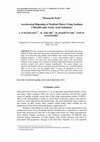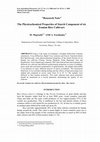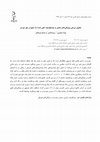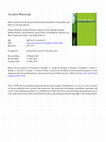Papers by Dr Mahsa Majzoobi

Journal of Texture Studies, Jul 23, 2015
ABSTRACT The objective of this study was to improve the shelf-life and nutrition quality of bread... more ABSTRACT The objective of this study was to improve the shelf-life and nutrition quality of bread by combination of part-baked frozen technology and white wheat flour replacement with 0, 10, 20 and 30% (w/w) of whole oat flour (WOF). Part-baked breads were produced at 200 °C for 7 min followed by freezing at -18 °C for 1, 7, 14, 21, 28 days and re-baking at 230 °C for 8.5 min. Increasing the level of WOF enhanced water absorption, dough development time and dough softening while reduced dough stability time. Peak viscosity, trough and final viscosities reduced while pasting temperature increased. Baking weight loss increased with frozen storage time but reduced with addition of WOF. Frozen storage time and flour replacement enhanced bread density and firmness. Inclusion of maximum 10% WOF resulted in bread with similar sensory properties to those of control with a minimum shelf-life of 28 days at -18 °C. Oat grains are well-known for their health benefits and have been used in bread and other foods to improve their nutritional value. Oat bread has been produced already by conventional methods, while there is little information to show the possibility of production of oat bread using part-baked frozen breads technology. This technology has a growing market since it can enhance the quality and shelf-life of the bread. The results of this research indicated that replacement of maximum 10% wheat flour with whole oat flour can result in satisfactory part-baked bread with frozen shelf-life of 28 days. This study can provide further information on application of whole oat flour as an excellent source of dietary fiber (mainly β-glucan) and bioactive compounds with health benefits in bread production industry in order to respond to the increasing demand for a wider variety of healthy breads with longer shelf-life.
The Royal Society of Chemistry eBooks, Dec 11, 2009
Journal of Texture Studies, Jun 14, 2011
ABSTRACT

Iran Agricultural Research, 2010
In this research, the accelerated ripening of the Kabkab dates from Khalal to Tamr using NaCl and... more In this research, the accelerated ripening of the Kabkab dates from Khalal to Tamr using NaCl and acetic acid solutions was studied. Fruits at Khalal stage were harvested and washed with distilled water before being treated with ripening inducers: 1. NaCl solutions, 2. acetic acid solutions and 3. Aqueous solution of NaCl (1%) and acetic acid. moisture, pH, colour, brix and textural firmness of the samples were monitored. Results indicated that during ripening the moisture content and colour changed significantly. The major change was observed for firmness where a maximum force for puncture test varied from about 1000 to 50 g force for all samples after 72 hours of incubation at 40 °C. Harvesting at Khalal stage followed by treating the fruits with NaCl and/or acetic acid solutions and an incubation stage at 40 °C showed to be a promising method for accelerated ripening.

Iran Agricultural Research, 2009
Using a wide range of techniques, including differential scanning calorimetry, X-ray diffraction,... more Using a wide range of techniques, including differential scanning calorimetry, X-ray diffraction, Rapid Visco Analyser and Fourier Transform Infera Red Spectroscopy, some physicochemical properties of the starch fraction of six Iranian rice cultivars (Tarom, Tarome Hashemi, Neda, Ramezani, Fajr and Kamfirouzi) [1]were studied and compared. DSC data showed that starch granules of different rice cultivars had different gelatinization properties in terms of enthalpy, onset, peak and conclusion temperatures of gelatinization. All samples had similar X ray patterns (A type), different degrees of starch crystallinity. The rheological behaviour of rice powders during heating and the effects of heat processing were studied and compared in excess water from 25 to 95 °C. The samples were different in their pasting properties. This study indicates that starch properties should be mentioned as a crucial parameter determining the quality of rice cultivars.

International Journal of Food Science & Technology, 2021
SummaryLupin is an economical source of protein, fibre and bioactive compounds, and to obtain the... more SummaryLupin is an economical source of protein, fibre and bioactive compounds, and to obtain these health and nutritional benefits lupin flour has been used in bread production. However, addition of more than 10% lupin flour markedly reduces bread quality mainly due to gluten dilution. The main aim of this research was to retain lupin bread quality enriched with higher percentages of lupin flour (20%) by addition of vital gluten powder (0%, 2%, 3.5% and 5%), investigating the effects of lupin variety (Lupinus albus and L. angustifolius) and two baking systems (rapid and sponge & dough). Impact on bread staling qualities was also determined through texture analysis of samples over a 72‐h storage period. Compared to lupin bread with nil gluten addition, significant improvements in loaf volume and crumb texture were observed with addition of gluten powder especially at 5% which increased loaf volume by an average of 20% across lupin sources and baking methods, and crumb softness by 30...
Journal of Agricultural Science and Technology

Oat contains considerable amount of β-glucan and hence is known as a functional cereal. β-glucan ... more Oat contains considerable amount of β-glucan and hence is known as a functional cereal. β-glucan is a fiber that has positive effects on human health. On the other hand, the average consumption of fiber is lower than recommended values. Accordingly, diseases such as coronary and heart disease as well as obesity are increasing. The main aim of this study was to increase the fiber content of biscuits as a favorite food of low fiber content. Therefore, the effects of replacement of oat bran (as a rich source of fiber) at different levels (0, 5, 10, 15 and 20%) with wheat flour on the characteristics of the dough and biscuit was studied. The results showed that the Young modulus of the dough increased, while springiness and adhesiveness decreased. In addition, the biscuits became harder and the force required to break the biscuits decreased. Determination of the biscuits color showed that the darkness, redness and yellowness of the samples increased with increasing the quantity of the b...

Journal of Texture Studies, 2015
ABSTRACT The objective of this study was to improve the shelf-life and nutrition quality of bread... more ABSTRACT The objective of this study was to improve the shelf-life and nutrition quality of bread by combination of part-baked frozen technology and white wheat flour replacement with 0, 10, 20 and 30% (w/w) of whole oat flour (WOF). Part-baked breads were produced at 200 °C for 7 min followed by freezing at -18 °C for 1, 7, 14, 21, 28 days and re-baking at 230 °C for 8.5 min. Increasing the level of WOF enhanced water absorption, dough development time and dough softening while reduced dough stability time. Peak viscosity, trough and final viscosities reduced while pasting temperature increased. Baking weight loss increased with frozen storage time but reduced with addition of WOF. Frozen storage time and flour replacement enhanced bread density and firmness. Inclusion of maximum 10% WOF resulted in bread with similar sensory properties to those of control with a minimum shelf-life of 28 days at -18 °C. Oat grains are well-known for their health benefits and have been used in bread and other foods to improve their nutritional value. Oat bread has been produced already by conventional methods, while there is little information to show the possibility of production of oat bread using part-baked frozen breads technology. This technology has a growing market since it can enhance the quality and shelf-life of the bread. The results of this research indicated that replacement of maximum 10% wheat flour with whole oat flour can result in satisfactory part-baked bread with frozen shelf-life of 28 days. This study can provide further information on application of whole oat flour as an excellent source of dietary fiber (mainly β-glucan) and bioactive compounds with health benefits in bread production industry in order to respond to the increasing demand for a wider variety of healthy breads with longer shelf-life.
Food Biophysics, 2011
Page 1. ORIGINAL ARTICLE Modeling the Effect of Glucose Syrup on the Moisture Sorption Isotherm o... more Page 1. ORIGINAL ARTICLE Modeling the Effect of Glucose Syrup on the Moisture Sorption Isotherm of Figs Sara Ansari & Asgar Farahnaky & Mahsa Majzoobi & Fojan Badii Received: 1 November 2009 /Accepted: 7 February ...
Journal of Texture Studies, 2011
ABSTRACT

Journal of Texture Studies, 2010
ABSTRACTThe effects of hydroxypropyl cellulose (HPC) on the quality of the ordinary wheat flour d... more ABSTRACTThe effects of hydroxypropyl cellulose (HPC) on the quality of the ordinary wheat flour dough and spaghetti were studied. The determination of the rheological properties of the dough showed that the peak consistency, stability time, band width (determined by a farinograph), maximum force and elasticity (determined by a texture analyzer) of the HPC sample were higher while its viscosity was lower than those of the control. Scanning electromicrographs of the samples indicated that the HPC made a network on the surface of the starch granules. Based on the results, the HPC sample had higher water absorption, longer cooking time and less cooking loss than the control. Cooked HPC sample had higher cohesiveness and breaking point strength, while it had lower adhesiveness and stringiness than the control (determined by a texture profile analyzer). It also had better organoleptic and higher general acceptability than the control.PRACTICAL APPLICATIONSIn some areas where semolina is n...

Journal of Texture Studies, 2013
In this research, edible films were produced using native wheat starch with different concentrati... more In this research, edible films were produced using native wheat starch with different concentrations of glycerol (0, 20, 30, 40 and 50% of starch dry weight basis). Starch films were prepared by casting after gelatinization. The effects of glycerol on the microstructure, crystallinity, solubility in water, moisture absorption, water vapor permeability, optical and mechanical properties of the films at 25C and relative humidity range of 11–84% were investigated. The increase of glycerol content led to increase in film solubility, lightness, more compact structures and water absorption at 25C. The lowest water vapor permeabilities were found for the films with 20 and 30% glycerol. Glycerol did not change X‐ray patterns of starch films; however, the degree of crystallinity reduced. In general, for all starch films stress at break and Young's modulus decreased and elongation increased when glycerol concentration and/or RH increased.Practical ApplicationThe inclusion of glycerol into...
Journal of Food Science, 2002
Journal of Food Processing and Preservation, 2012
Journal of Agricultural and Food Chemistry, 2009
International Journal of Food Science & Technology, 2011
... Mohsen Gavahian,1 Asgar Farahnaky,1,* Mahsa Majzoobi,1 Katayoun Javidnia,2 Mohammad Jamal Sah... more ... Mohsen Gavahian,1 Asgar Farahnaky,1,* Mahsa Majzoobi,1 Katayoun Javidnia,2 Mohammad Jamal Saharkhiz3 & Gholamreza Mesbahi1 ... the Flora of Turkey (Jalas, 1972, 1982a,b). This plant in Iran has the local name of Avishan Shirazi (Shirazi thyme) (Hosseinzadeh et al ...
International Journal of Food Properties, 2008








Uploads
Papers by Dr Mahsa Majzoobi